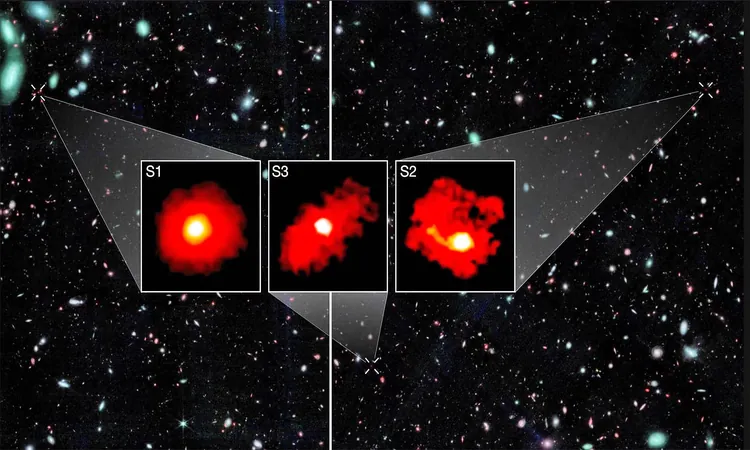
Unveiling the 'Red Monsters': A New Dawn in Cosmic Discovery!
2025-05-03
Author: Jessica Wong
The Webb Telescope has opened breathtaking new vistas in our understanding of the universe, revealing not just faint galaxies, but a stunning trio of colossal "red monster" galaxies that date back to within a billion years post-Big Bang!
Instead of the expected faint infant galaxies, astronomers were astonished to uncover these massive entities, some equal in size to today’s Milky Way. This discovery challenges previous notions in astrophysics, suggesting it's time to reconsider how swiftly stars and galaxies can form.
A Deeper Dive into the FRESCO Survey
To decipher these revelations, an international team analyzed data from Webb's FRESCO survey, which combines detailed imaging with spectra that pinpoint a galaxy's distance and age. Out of 36 observed galaxies, most showed expected characteristics, but three seemed to defy conventional wisdom.
These three distinct galaxies boast stellar masses over 10^10 times that of our Sun, a remarkable feat during a period when the universe was still in its infancy. Collectively, they contributed to an astonishing 17% of all star formation in their era.
Unearthing a Cosmic Efficiency
Lead researcher Dr. Mengyuan Xiao from the University of Geneva noted, "Our findings are reshaping our understanding of galaxy formation in the early universe." These galactic giants displayed an incredible efficiency, transforming about half of their available matter into stars—significantly more than what typical galaxies achieved.
The Mystery of the 'Red Monsters'
Dubbed 'red monsters' due to their appearance in the near-infrared spectrum, these galaxies were previously obscured by dust, which earlier telescopes couldn’t penetrate. Now, with Webb's advanced capabilities, their light reveals hidden star-forming regions that have been concealed for eons.
Dr. David Elbaz of CEA Paris-Saclay remarked on this breakthrough, emphasizing the transformative power of Webb's tools.
Rethinking Galaxy Formation Models
Traditionally, cosmologists believed dark matter halos were responsible for star formation by collecting gas that eventually cools into stars. Yet, the 'red monsters' suggest there might be shortcuts to galactic growth born from unique early conditions, such as higher gas densities or more frequent mergers.
Dr. Xiao concluded, "As we study these galaxies in greater detail, they could substantially illuminate the early epochs of the universe. This is just the beginning of an exciting new era in our cosmic exploration!"
Why This Matters for Cosmology
Looking back 13 billion light-years allows us to witness the cosmos in its formative years. The rapid emergence of these gigantic galaxies compels scientists to reevaluate their theories about gas cooling rates, stellar explosions, and the formation dynamics of cosmic structures.
What Lies Ahead?
Future initiatives using Webb and other facilities like ALMA promise to expand our knowledge of these early massive systems. Whether these 'red monsters' are rare outliers or signs of a bustling cosmic environment will influence how we understand star formation in our universe's youth.
Ultimately, as astronomers continue peeling back the layers of cosmic history, we are likely to uncover that the universe's early years were far more vibrant and dynamic than previously imagined, full of uncharted secrets waiting to be unveiled.






 Brasil (PT)
Brasil (PT)
 Canada (EN)
Canada (EN)
 Chile (ES)
Chile (ES)
 Česko (CS)
Česko (CS)
 대한민국 (KO)
대한민국 (KO)
 España (ES)
España (ES)
 France (FR)
France (FR)
 Hong Kong (EN)
Hong Kong (EN)
 Italia (IT)
Italia (IT)
 日本 (JA)
日本 (JA)
 Magyarország (HU)
Magyarország (HU)
 Norge (NO)
Norge (NO)
 Polska (PL)
Polska (PL)
 Schweiz (DE)
Schweiz (DE)
 Singapore (EN)
Singapore (EN)
 Sverige (SV)
Sverige (SV)
 Suomi (FI)
Suomi (FI)
 Türkiye (TR)
Türkiye (TR)
 الإمارات العربية المتحدة (AR)
الإمارات العربية المتحدة (AR)